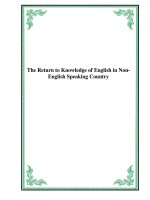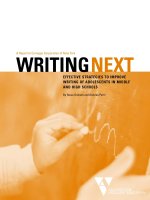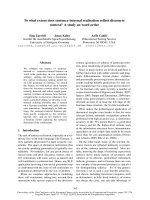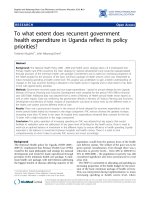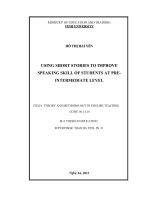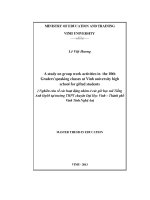To what extent does extensive reading affect the l2 proficiency of students at lower intermediate level of english in vinh phuc high school for the gifted
Bạn đang xem bản rút gọn của tài liệu. Xem và tải ngay bản đầy đủ của tài liệu tại đây (169.22 KB, 24 trang )
SỞ GIÁO DỤC VÀ ĐÀO TẠO TỈNH VĨNH PHÚC
TRƯỜNG TRUNG HỌC PHỔ THÔNG CHUYÊN VĨNH PHÚC
BÁO CÁO CHUYÊN ĐỀ
Examining the impacts of Extensive Reading on the English
language proficiency of grade 11 students in Vinh Phuc high
school for the gifted: A pilot study
Giáo viên: Trần Thị Thùy
Môn
: Tiếng Anh
Tổ bộ môn
: Ngoại Ngữ
Vĩnh Phúc, năm 2015
Contents
1. Reasons for choosing the study
Various attempts at different levels have been made to improve the
quality of teaching and learning English at school. In fact, the Ministry
of Education and Training has recently suggested that by the year
2020, at least half of the young should be able to use English fluently,
and this is a goal for teachers of English and education authorities to
work towards. The main challenges lay, however, in the lack of human
resources to cater for such need and the lack of motivation to learn
English from the students.
In a workshop in 2011, the writer was exposed to Extensive Reading, an
“aid to language learning” which has been reported to work in many
an Asian countries. By doing a great amount of reading under the
language teacher’s instruction and facilitation, students are claimed to
make steady progress in all language components and language skills.
It is therefore believed that extensive reading can be the key to
language improvement which may be appropriate in our educational
setting, since it provides an alternative to the more common teachercentred mode in Vietnam and can hence deal with the two
aforementioned issues effectively. Implementing a programme of
extensive reading in a particular school, however, needs elaborate
preponderance. This study is therefore to serve as the first cycle of an
action research pilot study-the basis for the official formation of an
2
2
extensive reading club within a senior secondary school for the gifted
in Vinh Phuc.
2. Research question
To what extent does extensive reading affect the L2 proficiency of
students at lower intermediate level of English in Vinh Phuc high school
for the gifted?
3. Subjects of the study
The primary subject of the study is the vast amount of literature on
extensive reading. Besides, there are eight students acting as the
control group and another eight participating in the first cycle of the
extensive reading club.
4. Aims and significance of the study
The study aims to explore the possible impacts of Extensive Reading on
learners’ L2 proficiency and examine the relevance of this approach in
a special senior secondary school for the gifted in Vinh Phuc. This
action research may subsequently encourage similar schools in the
area
to
consider
including
extensive
reading
into
their
teaching/learning, either as part of a required curriculum or as an
extra-curricular programme.
5. Limits of the study
3
3
Should there be more participants and a lengthier period of
programme implementation, this study could be considerably
improved.
6. Methodology
The study involves reviewing and summarising the literature on
extensive reading. This is followed by observation of and informal
conversations with 16 students in both the control and experimental
group. Finally, formal assessment of learners’ language proficiency in
the forms of tests ( pre-tests, progress tests, post-tests) and journal
entries written by students during the implementation of the
programme are also analysed and compared.
7. Research time
March 2014 – January 2015
4
4
Part 2. Theoretical background
1. Extensive reading: A definition
Extensive
reading
is
understood
as
an
approach
to
language
learning/teaching which is “generally associated with reading large amounts
with the aim of getting an overall understanding of the material. Readers are
more concerned with the meaning of the text than the meaning of individual
words or sentences.” (Day &Bramford, 2002).
2. The benefits of extensive reading
Bell (1998) summarised a number of advantages of extensive reading, from
positive psychological aspects to real language enhancement, of which the
most important are listed below:
a. The provision of authentic, 'comprehensible input'
It has always been proposed that that extensive reading will lead to language
acquisition, provided that certain preconditions are met, including adequate
exposure to the language, interesting material, and a learner-friendly
environment.
b. The enhancement of learners' general language competence
Extensive reading increases the opportunity for the learner-reader to
practise his automaticity of word recognition and decoding the symbols on
the printed page (often called bottom-up processing). In a study on an
extensive reading project with school children by Elley & Manghubai (1983),
5
5
significant post treatment gains in word recognition and reading
comprehension was reported to be gained after the first year, and wider
gains in oral and written skills after two years.
c. The increase of the students' exposure to the language
It is a fact that the quality of exposure to language that learners receive is of
great importance to their ability to acquire knowledge, whether in terms of
grammar or lexico, from the input. Elley’s (1991:404) researched subjects in
an extensive reading programme showed rapid growth in language
development compared with learners in regular language programs. He
claimed to have seen a "spread of effect from reading competence to other
language skills - writing, speaking and control over syntax,"
d. Increased knowledge of vocabulary
It is suggested that only a small percentage of vocabulary learning is due to
direct vocabulary instruction, the remainder is acquisition of words from
reading. Traditional approaches to the teaching of vocabulary, in which the
number of new words taught in each class was carefully controlled (words
often being presented in related sets), is therefore not sufficient in promoting
vocabulary growth. Exposing leaners to reading text can fill in the gap.
e. Improvement in writing
With such regular peruse of “comprehensible input”, there have been
reported significant improvements in subjects' written work. Extensive
reading is accordingly an effective means of fostering improvements in
students writing.
f. Increased motivation for learners to read
As Bell (1998) put it “reading material selected for extensive reading
programs should address students' needs, tastes and interests, so as to
6
6
energize and motivate them to read the books”. With some need analysis in
advance, the organiser/teacher can easily identify the appropriate genre(s)
for their students to read, for example by means of informal discussion or the
delivery of a need analysis questionnaire. In many cases, familiar material
and popular titles reflecting the local culture, or, paradoxically, stories of
faraway land and strange customs and practices could be the most popular
among school children and even teenagers.
g. Consolidation of previously learned language
The authentic, or near-authentic choice of books to read also mean that by
reading students can experience what is termed the “recycling” of language.
This is by itself a form of reinforcement which helps to ensure that new input
is “retained and made available for spoken and written production” (Bell,
1998).
h. Confidence with extended texts
It is the case that all classroom reading work in our course books are
traditionally focused on the exploitation of shorts texts. Gradually the
average student could be accustomed to reading those “simple-looking” texts
that he/she would back up when asked to read longer, more complex ones for
academic purposes. Extensive reading can therefore provide a “fun”, stressfree approach to the acclimatisation of students with these longer texts.
3. Principles of an extensive reading programme
Drawing on their experience with different extensive reading programmes,
researchers (Day, 2002; Bramford, 1998; Maley, 2008) have proposed a
number of criteria on which to develop a standard programme which could
7
7
be useful for future reference. Some of the most widely known and well
supported ones are as follows:
a. Maximize Learner Involvement
This is meant to reduce the feeling of obligation which may impede students’
automaticity both during the whole programme and during their individual
act of reading. Particularly, students should be encouraged discuss with the
teacher to identify their own interest in reading, for instance, whether it is
books about the environment/space or fiction books. For students in Vinh
Phuc senior secondary school for the gifted, this involvement is highly
desirable. From a psychological point of view, most of the students here,
being teenagers, have very strong face-saving needs and the teacher’s failure
to give them a sense of “ownership” of their reading project may cause
feelings of compulsion and later dissatisfaction.
b. Provide a wide range of texts
It is strongly believed that some variety in terms of genre and length of texts
can minimize the student’s chance of feeling bored. For the success of any
lengthy project, there should be abundant reading materials available in a
range of genre and length. The teacher should note, however, that whatever
type of material, the language presented must be within the language
competence of the reader-student.
c. Avoid the use of tests
As testing in our context is often associated with rote learning, memorization
and lack of freedom, extensive reading done at home or during an agreed
period of time assigned should be totally detached from testing.
d. Discourage the over-use of dictionaries
8
8
Dictionary use may harm the flow of the reader if she/he concentrates too
much on looking up the meaning of every single new word. Pickard
(1996:155) comments that, for the extensive reader-learner "Use of the
dictionary was sparing, with the main focus on meaning". Similarly, Day
(2002) suggests no dictionary use during reading as most of the chosen
material should be “comprehensible input”
e. The teacher’s role
There is a shift in the roles that the teacher plays in an extensive reading
programme with those she/he does in a normal classroom setting. He/she no
longer directs the students’ learning. Rather, she/he facilitates it. Besides,
Bramford (1998) points out that in order to administer the resources
efficiently, and to trace students' developing reading habits and interests,
effective monitoring from the teacher is fundamental.
f. Maintain the entertainment factor
This is in fact the key to any extensive reading programme. Only when
students are delighted with what they are doing can they continue with their
work. Once the fun is kept, automaticity and self-adjustment along the way
can be more feasible. Entertainment can be achieved by different ways yet
the vast amount of responsibility is on the teacher as a facilitator. Her/his
creativity, suitable follow-up activities, good management skills may help.
9
9
Part 3. The study
3.1 Participants
The participants in this study were 16 students from an Englishmajored class in Vinh Phuc high school for the gifted. Being from the
same class, they have the same amount of exposure to English, which is
five periods a week (three hour and a half) in the morning. The
participants were selected on the basis that their language proficiency
were roughly the same, i.e intermediate level. The students were at
grade 11 and studied English with the same teacher in their
(compulsory) morning classes. None among them went to an extra
English course of any kind or had any exposure to English during the
time of the study. The researcher decided to introduce Extensive
Reading in the form of a reading club with a membership of nine (one
teacher/researcher functioning as a participant and eight students)
The club met once every four weeks. Participation is voluntary and full
consent was granted from their parents.
3.2 Materials
3.2.1. Reading materials
10
10
An important principle of ER is that the input should not be imposed
upon the readers, but rather be chosen by the readers based on their
personal preferences and interests. For the project to work, the teacher
had to make sure that the “comprehensible input” students get exposed
to is abundant and validated. In total, there were 50 stories, 15 poems
and 20 non-fiction books of various levels (2-5) being used throughout
the project (See Appendix 1 for a sample of the material). Prior to
project implementation, the participants were consulted regarding the
genres of the books to be purchased, which explains how fiction seemed
to predominate.
3.2.2. Tests
These included a pre-project test (hereby pre-test) and a post-project
test (hereby post-test) selected from the abundance available online for
classifying students into suitable reading levels (graded readers, level
1-6). It should be noted that the two tests were designed in such a way
that they were considered of the same difficulty level, which the
participating students were unaware of. The tests comprised of two
sections: writing, which occupied two third of the total score, and
reading, which made up for the remaining one third.
3.3 Procedures
Pre-tests were administered at the beginning of the programme, which
helped in determining the level(s) of the students and choosing the
most suitable candidates from the volunteers. The 16 chosen
participants were then divided into two groups of equal membership.
The control group did not join the extensive reading club and
functioned as the reference point from which to assess the assumed
11
11
progress of the experimental group. The latter’s members underwent a
process of needs analysis in the form of informal conversations in order
that the appropriate reading materials could be acquired according to
their wishes. Subsequently, they formed pairs and started selecting
what to read from the newly acquired resources (graded reader series
of Oxford, Pearson, and Penguin). The experimental group, being
relatively small in size, met once every four weeks to reflect on their
own progress and carry out a number of follow-up activities with the
researcher/mentor’s presence as a participant (as opposed to a
teacher/mentor/researcher). Those are crucial in monitoring the
students’ performance and progress and maintain a sense of continuity
among the subjects studied. Below are some activities recommended
by Bramford (1998) and Day (2002), and which were employed in the
project.
• The Reader Interview
Regular conferencing among students on what they had read
and on their opinion on the book.
• Read Aloud to the Class
A student read some favourite extracts outloud to the class and
then share his/her thinking on the parts. This act provided a
model of how to correctly pronounce a word and how to read
with emotion. Students then followed.
•
Student Presentations
Students were encouraged to make short presentations on books
of their choices.
12
12
•
Follow-up written reports/ blurbs/ reviews
Contests were organised in which students chose to write a
report on a book they had read or an alternative blurb to the one
used by the publisher.
•
Project journal
A journal was kept which recorded the experimental group’s
feelings and their “new” discoveries/ reflection as the reading
programme progressed.
At the end of the project, a post-test of the same difficulty level as the
pre-test were given to both groups. Results were collected, analysed
and compared to identify the difference between the two groups’
performance and decide if any real progress had been made among
members of the experimental group as opposed to those from the
control group. In addition, throughout the project, the participants had
kept a project journal, which later contributed to the researcher’s
understanding of the subjects’ opinion of their own progress.
3.4. Results
3.4.1 Test results
Table 1 and 2 compare how members of the two groups scored in
different sessions of
the pre-test - i.e. the one before the
implementation fo the reading project. The maximum score for the test
is 30.
As the students researched were selected according to their English
proficiency, which was low intermediate level, their performance in the
pre-test reflected exactly this. The minimum score for the experimental
13
13
group was 14 out of 30 and the maximum score was 17. For the control
group, the corresponding figures were 15 and 18. It is clear that before
the project, the discrepancy among the 16 subjects’ command of
English, though existed, was inconsiderable as the scores from 14 to 18
fall into the same category of intermediate level. Bearing this small gap
in mind, however, the researcher made sure that those from the
experimental group had slightly lower average score than those from
the control group (15.75 compared to 16.125).
Name
Section 1
Section 2
Total score
Student 1
10/20
4/10
14/30
Student 2
12/20
6/10
18/30
Student 3
11/20
5/10
16/30
Student 4
9 /20
5/10
14/30
Student 5
10/20
7/10
17/30
Student 6
7/20
7/10
14/30
Stuent 7
10/20
6/10
16/30
Student 8
12/20
5/10
17/30
Table 1: Experimental group’s pre-test scores
14
Name
Section 1
Section 2
Total score
Student 1
9/20
6/10
15/30
Student 2
11/20
6/10
17/30
Student 3
11/20
5/10
16/30
14
Student 4
9 /20
7/10
16/30
Student 5
12/20
6/10
18/30
Student 6
8/20
7/10
15/30
Stuent 7
12/20
4/10
16/30
Student 8
10/20
6/10
16/30
Table 2: Control group’s pre-test scores
Table 3 and 4 illustrate the performance of the same groups’ members
in the post-test, which is of identical format and had the same level of
difficulty. For both groups, improvement in performance can be
noticed, with the average score for the experimental group and control
group being 22.75 and 18.5.
Name
Section 1
Section 2
Total score
Student 1
15/20
6/10
21/30
Student 2
19/20
9/10
28/30
Student 3
15/20
7/10
22/30
Student 4
12 /20
6/10
18/30
Student 5
16/20
10/10
26/30
Student 6
15/20
7/10
22/30
Stuent 7
16/20
9/10
25/30
Student 8
15/20
7/10
22/30
Table 3: Experimental group’s post-test scores
15
15
Name
Section 1
Section 2
Total score
Student 1
10/20
6/10
16/30
Student 2
12/20
6/10
19/30
Student 3
14/20
5/10
19/30
Student 4
13/20
6/10
18/30
Student 5
12/20
5/10
17/30
Student 6
9/20
7/10
16/30
Stuent 7
14/20
7/10
21/30
Student 8
14/20
8/10
22/30
Table 4: Control group’s post-test scores
3.4.2. Journal entries
The reading club members were advised to keep their own shared “club
diaries” in Vietnamese which reflected their insights into and feelings about
the programme. To avoid repetition and help keeping a certain degree of
anonymity, when a student found a journal entry with which she/he
concurred or resonated, she/he was invited to simply put a tick next to the
one. By the end of the project, with consent from the students, the researcher
read the diary thoroughly and identified the most salient features regarding
the participants’ perspectives on their “learning from reading” experience.
Overall, the most common features were listed below
Opinion/ Feelings
Transcript
Excitement
“A perfect husband” was interesting… H. told me her book is
16
16
sooo frightening..I’m not keen on ghost stories, but maybe I’ll
give it a try…”
“At first I was cool, but as all the others are reading book
after book, I have to rush too, and you know what? It’s totally
worth it..’
“I like it because we’re studying about the author in our
Literature Class in the morning, and when the teacher asks
me, I know everything…
Raised
awareness
different
shades
meaning of words
of “So today I’ve come to realise a normal word can have so
of amny interesting meaning, even words like DO…
“I know what flabbergasted is. And I also know a number of
other long words…I just don’t need a dictionary for that. I
learn it by reading.
“Sometimes I have a vague feeling that somehow by reading
a lot, I’ve learnt to use words more flexibly. Today in the
morning class I used the word “withering” and “faucet”. Well,
the teacher liked it. She even asked me “where do you get
that from?”
Confidence with longer “So, I’m not afraid of those reading passage anymore. But,
text
having said that, the passages in the textbook are so
different from our reading club books, right..”
“I’ve finished a looong story. And I don’t feel tired. Anything
but tired”
“Long, but it’s worth it. I was exhausted, but happy!”
Less
dependence
dictionary
on “so different from the texts in the coursebooks. I don’t like
texts there, I always feel the need to have a dictionary, but
reading like this, I feel like I can work out the meaning in
17
17
most cases…anyway, there seem to be fewer new words. Not
exactly like that, but I can understand the text better without
a dictionary. Maybe because I enjoy the story…?”
“I thin they write the book to help us learn without a
dictionary in many cases. I just understand…Anyway, the
teacher advised us against dictionary use, and I thought “I
won’t work that way”. But it did, somehow
3. 5. Discussion of the results and implications
It is unsurprising, perhaps, that improvements can be observed in all
students from the two groups involved considering the fact that during
the course of the reading programme both were having their morning
English classes as scheduled. What is striking here, nevertheless, was
the considerable gap in the post-test between the experimental and the
control group. While an average student in the reading club scored
22.75 out of 30 points, his counterpart in the control group did
remarkably lower, gaining a mere 18.55 points. Compared to the
starting point at which the former performed slightly worse than the
latter (15.75 as opposed to 18.125), it can be safely concluded that the
experimental group’s member did make significant progress than those
who were not involved in the extensive reading project.
Among the three skills tested (Listening, Reading and Writing), those in
the experimental group tended to make the greatest progress in
Writing. Reading, surprisingly, came only second, and the positive
changes in Listening, albeit remarkable in two cases (Student 2 and 6),
18
18
were not the norm for the rest. But for the short time available and the
limited number of subjects studied, it would be interesting to pinpoint
exactly the language component and skill benefiting the most from
Extensive Reading.
For the control group, best scored area of the exam was also the
Writing session, which was, however, on average 2 points lower in
comparison with the experimental group.
The above mentioned results may present a case for the introduction of
Extensive Reading into the current teaching contest in Vinh Phuc high
school for the gifted. This is further backed up by the close examination
of the journal entries, where, albeit several instances of feeling of
frustration and nerves, the majority of responses and comments were
highly positive and denoted a resolution to persevere with this
supposedly long-term project. Improved language competence aside,
there are probably many equally beneficial aspects of such a practice
as Extensive Reading, which again should be taken into consideration.
New areas worth researching emerge, for instance, how student
intrinsic motivation may change as a result of their participation in an
Extensive Reading project, or how the practice of reading in English
may influence their reading in their mother tongue.
19
19
Part 4. Conclusion
The study seeks to gain insights into the influences of extensive reading on
the L2 competence of eight students at lower intermediate level of English.
The results did highlight the possible benefits and relevance of extensive
reading in our educational setting. This ahs made a strong case for a greater
scale implementation of a similar reading project before any official
administrative decision to include this into the teaching curriculum can be
sought after.
Due to the limited experience in this field from the writer, and the limited
time possible for the research, problems and oversights are unavoidable. I
therefore would be grateful to any comments and criticism from the readers
for the betterment of this study.
20
20
REFERENCES
Bell, T, (1998) Extensive Reading: Why? and How? The IESL Journal, 12 (4)
Day, Richard, R. (2002) ‘Top Ten Principles for teaching extensive reading.’ Reading in a
Foreign Language. 14(2)
Day, Richard, R and Bamford, Julian.(1998) Extensive Reading in the Second Language
Classroom. Cambridge: Cambridge University Press.
Elley, W. B., & Manghubai, F. (1983). 'The effect of reading on second language learning.'
Reading Research Quarterly, 19/1, (pp 53-67).
Maley, Alan (2008) ‘Extensive Reading: Maid in Waiting’ in B. Tomlinson (ed) English
Language Learning Materials: a critical review. London/New York: Continuum pp133156
21
21
Appendix 1: Sample of a reading
text. Genre: Literature. Grade 5
The Devoted Widow
A widow weeping on her husband's grave was approached by an Engaging
Gentleman who, in a respectful manner, assured her that he had long
entertained for her the most tender feelings.
"Wretch!" cried the Widow. "Leave me this instant! Is this a time to talk to
me of love?"
"I assure you, madam, that I had not intended to disclose my affection," the
Engaging Gentleman humbly explained, "but the power of your beauty has
overcome my discretion."
"You should see me when I have not been crying," said the Widow.
(Ambrose Bierce)
22
22


